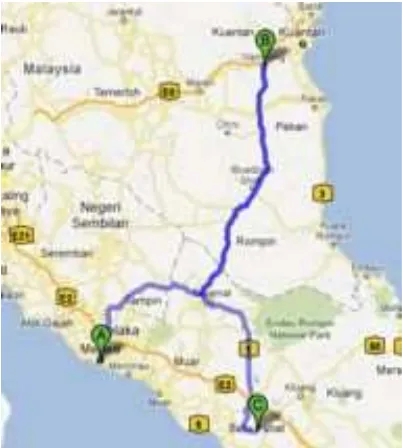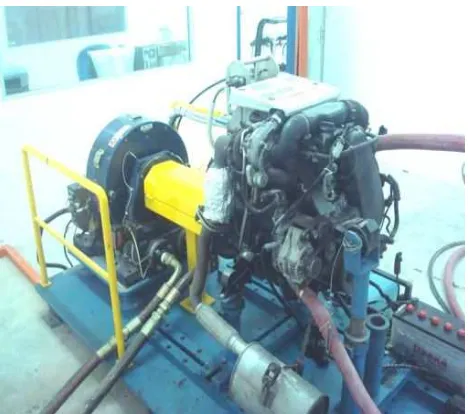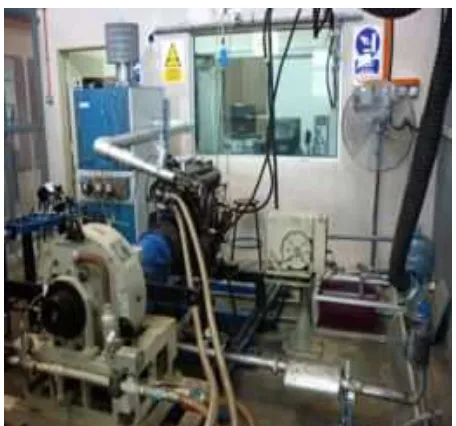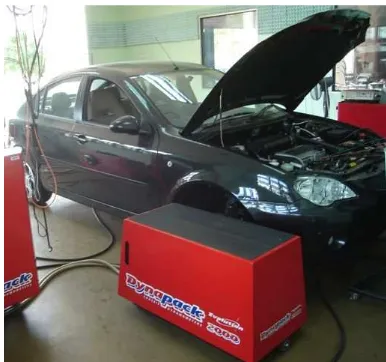Strategic Research Partnership on Automotive
Powertrain & Fuels in Universiti Malaysia Pahang,
Universiti Teknikal Malaysia Melaka & Universiti
Tun Hussein Onn Malaysia
A.J. Alimin1,*, N. Tamaldin2 and R. Mamat3 1
Dept. of Plant & Automotive Eng., Faculty of Mechanical & Manufacturing Engineering (UTHM) 2
Faculty of Mechanical Engineering, Universiti Teknikal Malaysia Melaka (UTeM) 3
Automotive Engineering Centre, Universiti Malaysia Pahang (UMP)
*Corresponding email: ajais@uthm.edu.my
Abstract
Malaysia has been known as one of the competitive automotive manufacturers and consumers in the ASEAN region. This is as a result of the government initiative of promoting the automotive industry as one of the key industries in Malaysia. However, depleting fuel sources, unstable oil price (Yr 2008, USD50/barrel – Yr 2011, USD100/barrel) and the increasing climate problems have prompt major research and development works on optimum automotive powertrain technologies with reduced emissions. Among the universities in the Malaysia Technical University Network (MTUN), three universities - Universiti Malaysia Pahang (UMP), Universiti Teknikal Malaysia (UTeM) & Universiti Tun Hussein Onn Malaysia (UTHM) - have take up the challenge in championing R & D works in producing efficient powertrain and emissions control systems. In this paper, existing research efforts and a proposed strategic partnership are outlined. This initiative will focus on
strengthening the research and consultancy capabilities that include utilization of research facilities and expertise among the universities. It is also expected that the outcomes from the partnership will foster better engagement between automotive related industries and universities, at the same time resolving the related R & D issues.
Keywords: automotive powertrain, fuels, internal combustion engine, emissions control
1. INTRODUCTION
It has been acknowledged that incomplete combustion of fossil fuels from motor vehicles is the prime source of the air pollutants. Gasoline and diesel-fuelled motor vehicles contribute to carbon monoxide (CO), unburned hydrocarbons (HC), as well as nitrogen oxides (NOX) and carbonaceous soot or particulate matter (PM) emissions, from their exhaust pipes. These emissions are considered as primary pollutants and their interactions with low level ozone and volatile organic compounds (VOC) will result to the formation of secondary pollutants such as photochemical smog and aerosols.
In Malaysia, transportation sector is one of the important sectors that drive the country economy; and statistic from Malaysia Department of Transport (DoT) shows that from 2003 until March 2008, the total number of vehicle registered is already 4.7 millions. These numbers will definitely increasing in the coming years. The latest Malaysia environmental quality
report by Department of Environment (DoE) stated that emissions load from all sources has increased in year 2006 than 2005. Motor vehicles are major contributor for NOX (70%), CO (98%) and also for sulphur dioxide-SO2 (9%) and PM (8%). In years 2005 and 2006, vans and trucks are the largest contributor for PM (68%), nitrogen dioxide-NO2 (63%) and SO2 (61%). Contributors for HC emission are motorcycles (61%), while for CO emission, passenger cars are responsible for 45%, followed by vans and trucks by 35%. Although Malaysia has a good environment to stabilise the pollutants but it has reached a critical level as witnessed during haze crisis.
petroleum based fuels with alternative fuels, natural gas, electrification and even combination of traditional internal combustion engine (ICE) with hybrid technology. However, associated problems and challenges with the non-petroleum fuels still require further works. This situation therefore demands extensive research works on automotive powertrain and emissions control to ensure the country economic and environmental sustainability. In this paper, brief Universiti Malaysia Pahang, Gambang, Pahang and (C) Universiti Tun Hussein Onn Malaysia, Parit Raja, Batu Pahat, Johor. Those universities are located in the southern Peninsular of Malaysia and are easily accessible via the main highways. In Pahang, UMP is very close to the Pekan automotive key player, DRB-HICOM. Meanwhile UTeM in Melaka is near to local HONDA assembly plant and vendors. UTHM, the furthest south, although not close to major automotive manufacturers/assemblers, it is nearby to local assembler Oriental Assemblers Sdn Bhd. Apart from the automotive related industries, these universities are within reach to other kind of industries – processing (oil, chemical, biodiesel), manufacturing and production.
Figure 1 – Locations of UTeM, UMP and UTHM
3. RESEARCH AND CONSULTATION WORKS Each of the above institutions boasts their own unique research strength and capabilities. Being relatively new universities, initial expansion mainly focus on human resource development and acquirement of new research facilities. As the universities progress, their respective researchers in automotive powertrain began forming research focus group or team. In this aspect, UTeM established Pusat Penyelidikan Automotif (CeVReD), in UMP the team moves under Automotive Engineering Centre and in UTHM, Automotive Powertrain Research Focus Group (ARG) was formed, with the coordination from Centre for Energy and Industrial Environmental Studies (CEIES), UTHM.
In general, each research team concentrates on research grant applications, supervision of postgraduate research, publication of proceedings and articles for journal as well as testing and consultation works for local industries (either major automotive role player or small scale industries). Some of the important facilities and on-going works, especially with regards to automotive powertrain and emissions reduction, are highlighted in the following sections.
3.1 Main facilities and activities – UTeM
There are two laboratories: engine testbed/steady state and chassis dynamometer/dynamic testing. Main testing equipments comprises an eddy type engine dynamometer, Mustang Dry Gap Eddy Current 150 series (MD-DGEC150) that is capable of handling at maximum: 150 kW of power, 500 Nm of torque and engine speed of 8000 rpm (refer Figure 2). The engine used to couple with the dynamometer is a Mitsubishi 4 cylinder inline diesel engine with 1998 cc displacement equipped with exhaust gas recirculation (EGR) and water-cooled turbocharger. For dynamic testing, DynoJet model 224xLC series chassis dynamometer is available, which is capable of performing loaded tests, including step, sweep, and wind drag simulation (refer Figure 3). The chassis dynamometer is compatible for either front or rear wheel drive vehicles. The specification of DynoJet 224xLC chassis dynamometer is shown in Table 1.
Figure 2 - Diesel engine on MD-DGEC150 Dynamometer
Figure 3 - DynoJet 224xLC Chassis Dynamometer testing a Proton Waja
Table 1 - Technical Specification of DynoJet 224xLC series
Maximum Horsepower 2000hp +
Maximum Speed 200MPH (322Kph)
Drums 1
Drum Diameter 24"
Drum Width 81"
Minimum Axle Width N/A Maximum Axle Width 79" Maximum Axle Weight 3000 lbs
Calibration Quick-call (included)
Eddy Current Standard
Air Requirements 100 psi
Operating Temp Range 32 to 158 degrees F
Figure 4 - Stargas 898 OBD scanner and gas analyzer
Looking at the capabilities of these two laboratories in UTeM, the potential research work to be explored in automotive industries is endless. In addition to fundamental combustion works, engine management system (EMS) development has become one of the important areas to be investigated by UTeM researchers. Some early works in EMS have begun in UTHM and UMP, and UTeM will enter this joint effort to further contribute to the automotive development in Malaysia. The centre also carried out evaluation and assessment on technologies for fuel economy and performance improvement.
3.2 Main facilities and activities – UMP
Automotive Engineering Center & Faculty of Mechanical Engineering, Universiti Malaysia Pahang working together to develop and establish an engine & fuel testing facility for research and consultation purposes. Their works in UMP focus on biofuel, compression ignition engine (diesel-fuelled) and also on aftertreatment technologies. Equipment already available consists of an inline 4-cylinder diesel engine equipped with twin-fuel tank, to enable study on different types of fuel. All equipment & engine installation fulfilled SAE standard engine setup procedure. Research performed included engine performance analysis following fuelling using palm oil methyl ester as compared to mineral diesel.
The test facility has a traditional layout, with the control room located next to the test cell with a window for visual monitoring in, as Figure 5. The control room houses the PCs built in with DEWETRON DAQ system, whereas the dynamometer controller with the measuring devices are attached to the engine in the test cell.
the trial.
The test rig uses a water-cooled Mitsubishi 4D68 SOHC Direct Injection, naturally aspirated 2.0L 4-stroke multi cylinders engine with EGR system (compression ratio of 22.4:1), with the maximum power of 65 kW at 4500 rpm. The diesel engine is also equipped with Kistler CAM crank angle encoder model 2613B to measure the crank angle and combustion characteristics. A water-cooled piezoelectric pressure transducer (Kistler 6041A) is mounted on the cylinder head to measure in-cylinder combustion pressure. The temperatures of the environment are obtained using RS K-type thermocouples.
DEWETRON computer based data acquisition (DAQ) system is used in the test cell whereas Orion 1624 E card installed on a PC DEWE-800 with 16 slots for DAQ/PAD modules and 2 PCI slots. Furthermore Spectrum MI.3111 DAQ card with 12-bit resolution that provides channel for Kistler crank angle encoder.
AIC fuel flow meter series 1204 is used for fuel flow rate measurement to the engine. Ambient temperature, relative humidity and dew point was measured in real time using EL-USB-RT with USB interface directly to the computer with data logger built in that can be saved through Excel.
An exhaust gas analyzer KANE systems complete with a 3-meter long sampling probe is used for emissions measurements. The sampling probes of smoke meter and gas analyzer are mounted centrally at the end of the engine exhaust pipe.
Figure 5 - Engine test cell layout in UMP
3.3 Main facilities and activities – UTHM
Officially established under the Department of Plant and Automotive Engineering, Faculty of Mechanical and Manufacturing Engineering in October 2008, the Automotive Powertrain Research Group (ARG) has been working in the area of automotive engineering and technology. ARG is established with the aim of promoting, conducting and supporting research and academic activities related to automotive engineering and technology. As the key player in automotive area in UTHM, the group is committed to carry out intensive research in the following areas:
a. Automotive and industrial emission control technology
b. Small engine technology c. Alternative and renewable fuels
d. Aerodynamics and Computational Fluid Dynamics (CFD)
Currently the team is working on retrofitting technology for small engine, aiming at power boosting and improvement in fuel economy, total utilisation of natural gas for mobile vehicle, EMS technology and development of emissions control system – catalyst support study as well as catalyst coating analysis.
Previous works also include investigation on the trade-off between EGR rates and smoke emissions from compression ignition (C.I.) engine fuelled using jatropha crude oil and its blends. In addition to that, there were also researches conducted on zeolite diesel particulate filter and emission suppression system for spark ignition (S.I.) engines. In UTHM, a 5-tonne capacity biodiesel process pilot plant is in full operation and the produced biodiesel and its blends are also being evaluated and analysed by the team. The team also forges close collaboration with SIRIM QAS International Sdn Bhd, specifically in evaluating and assessing engine improvement and fuel economy related products or systems.
Figure 6 – Dynapack chassis dynamometer
Figure 7 – Dynapack chassis dynamometer
Figure 8 – AUTOCheck Analyser
Figure 9 – Ono Sokki fuel consumption meter
Figure 10 – Ono Sokki fuel consumption meter
4. PROPOSED PARTNERSHIP
The expertises and facilities already established in these universities are more than ready to aggressively embark upon solving the problems relating to automotive powertrain and fuel consumption issues. Moreover, concerns for the environment and climate change have inadvertently chart the research directions of each university. Experiences accumulated in each institution in various research scopes – alternative fuelling, emissions reduction, retrofitting, EMS – must be harnessed efficiently to ensure positive outputs to the automotive manufacturers as well as to the society. Nevertheless, cooperative steps in addressing and generating innovative solutions must also be set in motion.
REFERENCES
[1] Tamaldin, N., Roberts, C.A., Benjamin S.F. (2010) - Experimental Study of SCR in a Light Duty Diesel Exhaust to Provide Data of a CFD Model Using the Porous Medium Approach, SAE2010-01-1177, SAE 2010 World Congress, Detroit, Michigan, April 13-15, 2010.
[2] Alimin, A. J., Roberts C. A. and Benjamin S.F. (2006) - A NOX Trap Study using Fast Response
Emission Analyzers for Model Validation, SAE2006-01-0685, SAE 2006 World Congress, Detroit, Michigan, 3-6 April 2006.
[3] Mamat, R., Abdullah, N. R., Tamaldin, N., (2010)
- Emissions of a Single Cylinder Diesel Engine
Operating with Ethanol, ENGINEERING
MECHANICS & TRANSPORT 2010” (EMT-2010), 25-27 NOVEMBER 2010, LVIV, Ukraine [4] Mustang Dynamometer MD-DGEC150 series
user manual.
[5] Dynojet Chassis Dynamometer 224-LC series user manual.
[6] Mat, S. (2007) - The Effect of Lean NOX Trap
(LNT) Catalyst on NO2 Removal from Diesel
Exhaust Engine, MSc Thesis, Coventry
University.
[7] Brace, C J., BURKE, R., Moffa, J., (2009) - Increasing accuracy and repeatability of fuel
consumption measurement in chassis
dynamometer testing, Proceedings of the
Institution of Mechanical Engineers MECHE, Part D: Journal of Automobile Engineering. [8] M.G. Gouda, A.J. Alimin & K.A. Kamaruddin
(2011) - Trade-off between NOX, soot and EGR
rates for an IDI diesel engine fuelled with JB5, Journal of Applied Sciences (JAS); 09/03/2011; Volume 11, Number 11, pg1987-1993
[9] M.F. Hushim, A.J. Alimin & L. Abdul Rashid (2011) - Port-Fuel Injection System for Small 4-Stroke Single Cylinder Engine: An Experimental
Framework, International Conference on
Mechanical & Manufacturing Engineering 2011 (ICME2011), 6-7 June 2011, #024
[10] M.F. Hushim et al. (2011) - Application of Green Technologies for UTHM in realising the Green Campus Concept, International Conference on Mechanical & Manufacturing Engineering 2011 (ICME2011), 6-7 June 2011, #100
[11] M.M. Taib, A.J. Alimin, S.H. Aminordin & H. Abdul Rahman (2009) - Feasibility of a Novel Diesel Particulate Filter for Reducing Soot Emission, Proceeding of Environmental Science and Technology Conference (ESTEC2009), Terengganu, Malaysia, 7-8/12/2009
[12] S.H. Aminordin et al. (2008) - Effects of Porous Ceramic/Zeolite to the Exhaust System of Gasoline Engine, Proceeding of International



